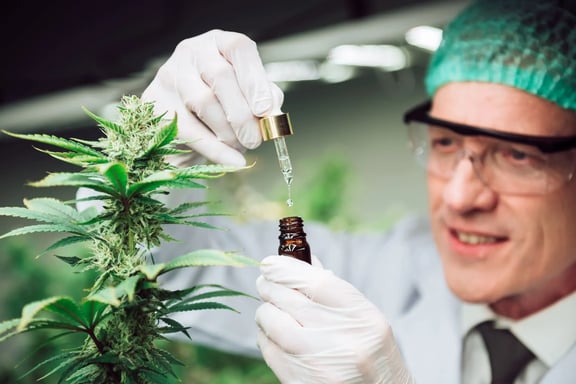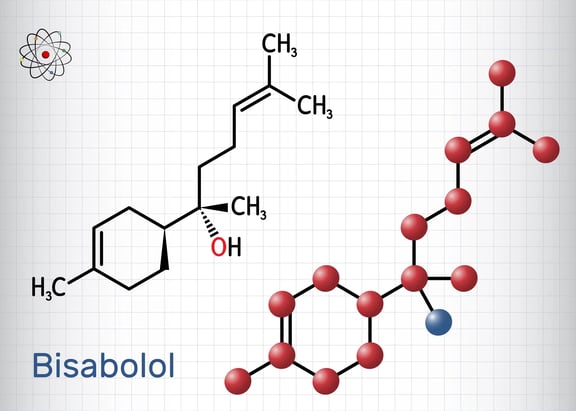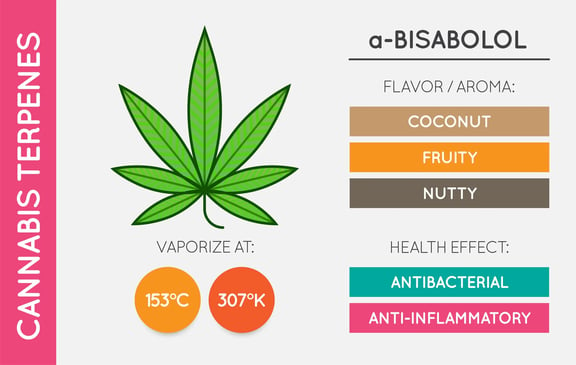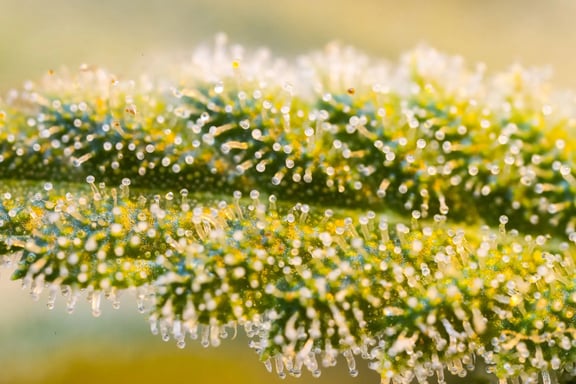Introduction
In the ever-evolving tapestry of cannabis strains, numerous elements come into play to shape the experience of each strain. Amongst these, terpenes serve as the unsung heroes, offering a myriad of effects, aromas, and flavours that define each variety.
One such lesser-known yet significant terpene is Bisabolol. Known for its subtle, sweet aroma, Bisabolol doesn’t limit its presence to cannabis but extends its reach into a broader botanical world. This article aims to explore the journey of Bisabolol from its botanical origins to its role in health and wellness, unearthing a terpene that’s as elusive as it is fascinating. If you’ve ever wondered why certain cannabis strains have that unique floral note or why your skin feels soothed after using certain cannabis-infused products, Bisabolol could be the unsung hero behind it all.
The world of cannabis is a complex one, filled with a plethora of compounds that contribute to its diverse effects and aromas. Terpenes like Bisabolol play a crucial role, often overshadowed by the more famous cannabinoids like THC and CBD. But make no mistake, understanding terpenes like Bisabolol can offer you a more nuanced appreciation of cannabis. Whether you’re a casual user or a cannabis connoisseur, knowing your terpenes can elevate your experience. So, sit back and let’s delve into the captivating world of Bisabolol, a cannabis terpene that’s as intriguing as it is beneficial.

The Enigma of Bisabolol: A Subtle Yet Significant Terpene
Diving into the chemical intricacies of Bisabolol, we’ll explore its structure, common isomers, and how it differentiates itself from other terpenes in the plant kingdom. Bisabolol, or more formally α-(−)-bisabolol, is a natural monocyclic sesquiterpene alcohol. It’s a colourless viscous oil and the primary constituent of the essential oil from German chamomile and, of course, certain strains of cannabis. Its complex structure and unique properties make it a terpene worth noting, especially for those keen on understanding the full spectrum of cannabis’ effects.
Bisabolol exists in various isomeric forms, each with unique properties and potential benefits. While the scientific nomenclature can get a bit overwhelming, what you need to know is that Bisabolol is more than just a background player in the cannabis experience. It holds its own, contributing to the aroma, flavour, and even the therapeutic effects of various cannabis strains. As Wikipedia notes, it’s a natural monocyclic sesquiterpene alcohol, a term that might sound like gibberish but is actually key to understanding its role in the broader botanical and cannabis realms.
The Nature of Bisabolol
Origin and Natural Occurrences
When it comes to the origins and natural occurrences of Bisabolol, the terpene has a rich history that extends beyond the cannabis plant. It’s also found in chamomile, a plant long revered for its calming effects. In the realm of cannabis, however, Bisabolol is often found in strains known for its soothing and anti-inflammatory properties. It’s this versatility that makes Bisabolol a terpene worth exploring, whether you’re into cannabis for recreational or medicinal purposes.
The presence of Bisabolol in various plants, including cannabis, is no accident. Each plant that contains this fascinating terpene has its unique aroma and therapeutic profile. For instance, chamomile, known for its calming effects, is rich in Bisabolol, which contributes to its anti-inflammatory properties. Similarly, certain cannabis strains rich in Bisabolol are often noted for their soothing effects, making them ideal choices for those looking to relax or relieve pain. As The Dermatology Review puts it, Bisabolol’s anti-inflammatory properties have been studied, showing its ability to inhibit proinflammatory cytokines, which may reduce skin inflammation and irritation.
Aroma Characteristics: The Sweet Essence
When it comes to the aroma profile of Bisabolol, this terpene is a bit of a show-stealer. It’s often described as having sweet, floral notes, reminiscent of fresh flowers and even a hint of spiciness. This unique aroma profile doesn’t just make Bisabolol-rich cannabis strains a treat for the senses; it also contributes to their therapeutic attributes. Whether you’re lighting up a joint or using a cannabis-infused skincare product, the sweet essence of Bisabolol is likely playing a role in the experience.
The aroma of Bisabolol is more than just a sensory delight; it’s a clue to its therapeutic potential. In aromatherapy, scents are often linked to specific emotional and physical effects. The sweet, floral aroma of Bisabolol is no exception. It’s often used in aromatherapy for its calming and anti-inflammatory effects, making it a popular choice for those looking to relax and unwind. According to New Directions Aromatics, Bisabolol is known for its sweet floral aroma and is commonly used in the cosmetic and skincare industry for its ability to help the skin absorb other active ingredients, enhancing their efficacy.

Bisabolol in Cannabis
Prevalence in Different Strains
When you venture into the world of cannabis, you’ll soon realise the prevalence of Bisabolol in many beloved strains. This terpene doesn’t just stop at lending its aroma; it goes further, influencing the effects of the strain on the user. Bisabolol’s concentration often categorises a strain as either indica or sativa, with higher levels generally associating with the former. This makes it a key player in the cannabis experience, especially for those who are particular about the effects they want to achieve.
The presence of Bisabolol in cannabis strains is not merely a footnote; it’s a significant chapter in the cannabis narrative. Strains rich in Bisabolol are often noted for their calming and anti-inflammatory effects, making them ideal for medicinal users. According to Terpene.info, Bisabolol is a terpene that has been shown to induce apoptosis in leukaemia cells, which could have potential anti-cancer properties. This makes it a terpene worth exploring, not just for the recreational user but also for those interested in the medicinal aspects of cannabis.
The Entourage Effect: Bisabolol’s Role
The tale of Bisabolol in cannabis gets even more intriguing when delving into its role in the entourage effect. This phenomenon refers to the synergistic play of cannabinoids and terpenes, enhancing the overall effect of the cannabis. Bisabolol, with its ability to modulate the effects of other cannabinoids, is a significant player in this synergistic dance, amplifying the therapeutic and recreational attributes of cannabis.
The entourage effect is a fascinating aspect of cannabis science, and Bisabolol plays a pivotal role. When combined with other cannabinoids and terpenes, Bisabolol can enhance or modulate the overall effects, making your cannabis experience more tailored to your needs. According to Leafly, the entourage effect is a proposed mechanism by which compounds present in cannabis which are largely non-psychoactive by themselves modulate the overall psychoactive effects of the plant. This makes Bisabolol a key player in the cannabis experience, especially for those who are looking for a more nuanced and tailored experience.
Identifying High-Bisabolol Strains
When it comes to identifying cannabis strains rich in Bisabolol, it’s not just about chasing that sweet, floral aroma. It’s about tuning into a particular vibe that such strains exude. Engaging with growers and dispensaries or relying on lab-tested products can aid this quest. The higher Bisabolol content often translates to a more calming and anti-inflammatory effect, making the identification worthwhile for those seeking a therapeutic cannabis experience.
But how do you go about identifying these strains? Well, technology has made it easier than ever. Many dispensaries now offer lab-tested cannabis, providing a terpene profile with Bisabolol levels. According to Cannabis Business Times, knowing the terpene profile of a cannabis strain can help consumers make educated decisions about which strain will give them the desired effects. This makes it essential for those keen on experiencing the unique attributes of Bisabolol to consult these profiles.
Beyond Cannabis: Bisabolol’s Broad Spectrum
Bisabolol doesn’t just limit itself to the cannabis plant; it ventures out, marking its presence in an array of other plants, each of which, interestingly, is known for its distinctive aroma and flavour profile. Whether it’s the soothing touch of chamomile or the invigorating scent of candeia, Bisabolol is there, laying down the aromatic foundation.
The journey of Bisabolol doesn’t stop at cannabis; it traverses further into the botanical realm, finding its essence in a medley of plants. According to New Directions Aromatics, Bisabolol is known for its sweet floral aroma and is commonly used in the cosmetic and skincare industry for its ability to help the skin absorb other active ingredients, enhancing their efficacy. This makes it a terpene worth exploring, not just for the cannabis enthusiast but also those interested in the broader spectrum of botanicals.
Bisabolol in Skincare and Cosmetics
Bisabolol has carved out a niche in the skincare and cosmetics industry. Known for its soothing and anti-inflammatory properties, it’s a common ingredient in products that calm irritated skin. This makes it a versatile terpene, useful not just in cannabis but also in everyday skincare routines.
Using Bisabolol in skincare products is more than just a trend; it’s backed by science. According to Cosmetics Design Europe, a study supports the anti-inflammatory effect of Bisabolol in skincare products. This makes it a go-to ingredient for those looking to soothe irritated skin, highlighting its versatility as a terpene that transcends its role in cannabis.
From Chamomile to Candeia: Diverse Sources of Bisabolol
Bisabolol’s journey doesn’t end with cannabis or skincare products; it’s a terpene that’s found in a variety of plants, each with its unique characteristics. Chamomile, for instance, is a well-known source of Bisabolol and has been used for centuries in herbal remedies. The terpene contributes to the plant’s calming effects, making it a popular choice for teas and essential oils.
Candeia is another plant rich in Bisabolol, often used in traditional Brazilian medicine. According to ScienceDirect, Bisabolol extracted from Candeia has been studied for its anti-inflammatory and wound-healing properties. This adds another layer to the multifaceted world of Bisabolol, making it a terpene that’s not just limited to cannabis but spans across various botanical realms.

The Healthful Promises of Bisabolol
Regarding the health benefits of Bisabolol, the terpene doesn’t disappoint. Known for its anti-inflammatory and soothing effects, it’s a natural choice for alleviating discomfort. Whether you’re experiencing it through cannabis or other botanical sources, Bisabolol has shown promise in combating inflammation.
But it doesn’t stop there. According to a study cited by PubMed, Bisabolol has shown potential anti-cancer properties. While the research is still nascent, the initial findings are promising, adding another dimension to this versatile terpene. This makes Bisabolol not just a cannabis terpene but a potential powerhouse in natural health solutions.
Potential Anti-Cancer Properties
Bisabolol’s potential extends beyond its anti-inflammatory properties; it’s also being studied for its potential anti-cancer effects. While the research is still in its early stages, the initial findings are promising and could herald a new chapter in the medical use of cannabis terpenes.
According to PubMed, a study has shown that Bisabolol can induce apoptosis in leukaemia cells. While this is far from conclusive, it does open up new avenues for research, making Bisabolol a terpene worth watching in the scientific community.
Scientific Inquiries and Future Directions
The scientific community’s interest in Bisabolol is burgeoning, with research focusing on its potential health benefits and therapeutic applications. While bisabolol has been a subject of interest due to its prevalence in cannabis and other botanicals, the scientific inquiry into its health benefits is still relatively nascent. This makes it a ripe subject for future research, promising a deeper understanding of this fascinating terpene.
According to Frontiers in Pharmacology, terpenes like Bisabolol are gaining attention for their potential therapeutic applications. This underscores the need for more rigorous investigations into Bisabolol, especially in its role as a cannabis terpene. The existing studies have mainly been conducted in vitro or animal models, and extrapolating these findings to human health remains a significant leap.
Uncharted Territories: What More to Uncover?
The uncharted territories of Bisabolol research beckon with the promise of unveiling a deeper understanding of this common yet intriguing terpene. The potential interactions of Bisabolol with other cannabinoids and terpenes, its precise mechanism of action, and the full spectrum of its health benefits are among the myriad facets awaiting exploration.
While the scientific community has made strides in understanding Bisabolol, there’s still much to uncover. According to ScienceDirect, Bisabolol has been studied for its anti-inflammatory and wound-healing properties, but the full spectrum of its health benefits remains largely unexplored. This opens up a plethora of opportunities for future research, making Bisabolol a subject of keen interest in the scientific community.
Chemical Composition and Synthesis
The Intricacies of Bisabolol’s Chemical Structure
Bisabolol, formally known as α- (-)-bisabolol, is an unsaturated monocyclic sesquiterpene alcohol with the scientific name of alpha,4-dimethyl-alpha-(4-methyl-3-pentenyl)-3-cyclohexene-1-methanol (ScienceDirect). It’s a colourless viscous oil that is poorly soluble in water but dissolves well in ethanol. The chemical formula is C15H26O, with a molar mass of 222.372 g·mol−1 (Wikipedia). This section will delve into the chemical structure of Bisabolol, shedding light on its unique properties that make it a standout terpene in cannabis and beyond.
The Art of Synthesising Bisabolol
The biosynthesis of Bisabolol is a fascinating subject. A terpene synthase gene, EeBOS1, appears to control the biosynthesis of (–)-α-bisabolol in Candeia plants (NCBI). Little is known about the α-bisabolol biosynthesis pathway in German chamomile, especially the transcription factors related to the regulation of α-bisabolol synthesis (ResearchGate). This opens up many questions and avenues for future research, especially in cannabis strains rich in Bisabolol.
The Aromatherapy Angle
The Soothing Scent of Bisabolol
Bisabolol has a weak sweet floral aroma and is used in various fragrances. It has also been used for hundreds of years in cosmetics because of its skin-healing properties (Wikipedia). In the realm of aromatherapy, Bisabolol serves as a calming agent, its sweet, floral notes offering a therapeutic experience that’s hard to match. This makes it a sought-after terpene in cannabis strains aimed at relaxation and stress relief.
The Therapeutic Benefits of Aromatherapy
Bisabolol is known to have anti-irritant, anti-inflammatory, and anti-microbial properties (Wikipedia). These attributes make it an ideal candidate for aromatherapy applications. When inhaled, the terpene can offer a range of health benefits, from reducing anxiety to alleviating symptoms of respiratory conditions. This is particularly relevant for cannabis users who are looking for strains that offer more than just a ‘high’.

Historical Use and Cultural Significance
The Timeless Appeal of Bisabolol
Bisabolol has been used for centuries, primarily in traditional medicine and skincare. It’s a primary component of German chamomile essential oil, which has been used in herbal medicine for hundreds of years to treat various conditions, from skin disorders to gastrointestinal discomfort (ScienceDirect). In the context of cannabis, this historical usage adds another layer of intrigue. It suggests that strains rich in Bisabolol may offer a broader spectrum of therapeutic benefits, echoing the wisdom of ancient herbal practices.
Cultural Practices and Modern Applications
While Bisabolol’s primary historical use has been in European herbal medicine, its applications have diversified. Today, it’s a common ingredient in cosmetics and skin care products, and its anti-inflammatory and skin-soothing properties are well-documented (Wikipedia). This cultural shift towards modern applications doesn’t diminish its historical significance but enhances it, especially considering the growing interest in cannabis strains rich in Bisabolol for their potential health benefits.
Regulatory Status
The Legal Landscape of Bisabolol in the UK
In the UK, Bisabolol is generally considered safe and is approved for use in cosmetics. However, the status of cannabis, and by extension, cannabis strains rich in Bisabolol, is more nuanced. Cannabis is a Class B controlled substance under the UK Misuse of Drugs Act 1971, making it illegal to possess, distribute, or cultivate. However, medical cannabis was legalised in 2018, allowing for the possibility of Bisabolol-rich strains being used for therapeutic purposes under medical guidance.
Safety Profiles and Considerations in the UK
While Bisabolol is generally considered safe for cosmetic use, it’s important to note that the UK’s Medicines and Healthcare Products Regulatory Agency (MHRA) does not evaluate the safety of terpenes in the same way it does for medicines. Therefore, consumers should exercise caution and consult with healthcare providers when using products, especially cannabis strains, rich in Bisabolol for therapeutic purposes.
Case Studies and Anecdotal Evidence
Real-World Applications: The Case Studies
The scientific community is increasingly recognising the potential of Bisabolol, not just as a soothing agent but also for its medical benefits. A study published on PubMed found that α-(-)-bisabolol significantly inhibited skin inflammation in mice, suggesting its potential as a therapeutic candidate for treating skin conditions. Another study available on NCBI provided substantial evidence of α-Bisabolol’s role in ameliorating myocardial infarct damage, a type of heart injury. These case studies not only validate the therapeutic claims surrounding Bisabolol but also open doors for its broader medical applications.
Anecdotal Evidence: The User Experience
While scientific studies offer a robust foundation, anecdotal evidence often provides a more relatable perspective. According to an article on Leafly, several cannabis strains rich in Bisabolol, such as Harle-Tsu and ACDC, are popular among users for their unique effects and benefits. These strains are said to display high levels of Bisabolol, which contributes to their anti-inflammatory, anti-irritant, antioxidant, anti-microbial, and analgesic properties. This real-world evidence adds a layer of credibility and humanises the scientific data, making it more accessible to the general public.
The Complex World of Bisabolol: A Summary
In the ever-evolving landscape of cannabis terpenes, Bisabolol stands out for its unique aroma and a plethora of potential health benefits. From its role in skincare to its emerging significance in medical research, Bisabolol is a multifaceted terpene that warrants attention. Whether you’re a casual user or a scientific researcher, the world of Bisabolol offers a rich tapestry of opportunities for exploration and understanding.
Bisabolol FAQs:
-
Bisabolol is a terpene known for its sweet, floral aroma. It’s commonly found in chamomile and certain strains of cannabis.
-
Unlike other terpenes that may have strong, pungent aromas, Bisabolol is known for its subtle, sweet scent. It also has unique health benefits, including anti-inflammatory and potential anti-cancer properties.
-
Bisabolol is primarily known for its anti-inflammatory, anti-irritant, and anti-microbial properties. It’s also being studied for its potential anti-cancer effects.
-
In the UK, Bisabolol is approved for use in cosmetics. However, cannabis, which can be rich in Bisabolol, is a Class B controlled substance, although medical cannabis was legalised in 2018.
-
Bisabolol interacts synergistically with other cannabinoids and terpenes in cannabis, enhancing the overall therapeutic and recreational effects of the plant.
-
Bisabolol is generally considered safe, especially in cosmetic applications. However, it’s always advisable to consult with healthcare providers for therapeutic uses.
-
Harle-Tsu and ACDC are examples of cannabis strains that are known to have high levels of Bisabolol.
-
Due to its soothing and anti-inflammatory properties, Bisabolol is commonly used in skincare products like creams, lotions, and serums.
-
While there are existing studies on its anti-inflammatory and potential anti-cancer properties, more research is needed to fully understand the range of its health benefits.
-
Look for products that have undergone third-party lab testing, and always consult with knowledgeable growers or dispensaries for cannabis strains rich in Bisabolol.












.jpg)